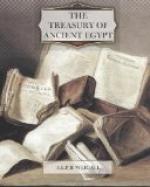[Photo by T. Capart.
In the same museum, and in others also, there are fragments of beautiful sculpture hacked out of the walls of the famous tomb of Khaemhat at Thebes. In the British Museum there are large pieces of wall-paintings broken out of Theban tombs. The famous inscription in the tomb of Anena at Thebes, which was one of the most important texts of the early XVIIIth Dynasty, was smashed to pieces several years ago to be sold in small sections to museums; and the scholar to whom this volume is dedicated was instrumental in purchasing back for us eleven of the fragments, which have now been replaced in the tomb, and, with certain fragments in Europe, form the sole remnant of the once imposing stela. One of the most important scenes out of the famous reliefs of the Expedition to Pount, at Der el Bahri, found its way into the hands of the dealers, and was ultimately purchased by our museum in Cairo. The beautiful and important reliefs which decorated the tomb of Horemheb at Sakkara, hacked out of the walls by robbers, are now exhibited in six different museums: London, Leyden, Vienna, Bologna, Alexandria, and Cairo. Of the two hundred tombs of the nobles now to be seen at Thebes, I cannot, at the moment, recall a single one which has not suffered in this manner at some time previous to the organisation of the present strict supervision.
The curators of western museums will argue that had they not purchased these fragments they would have fallen into the hands of less desirable owners. This is quite true, and, indeed, it forms the nearest approach to justification that can be discovered. Nevertheless, it has to be remembered that this purchasing of antiquities is the best stimulus to the robber, who is well aware that a market is always to be found for his stolen goods. It may seem difficult to censure the purchaser, for certainly the fragments were “stray” when the bargain was struck, and it is the business of the curator to collect stray antiquities. But why were they stray? Why were they ever cut from the walls of the Egyptian monuments? Assuredly because the robbers knew that museums would purchase them. If there had been no demand there would have been no supply.
To ask the curators to change their policy, and to purchase only those objects which are legitimately on sale, would, of course, be as futile as to ask the nations to disarm. The rivalry between museum and museum would alone prevent a cessation of this indiscriminate traffic. I can see only one way in which a more sane and moral attitude can be introduced, and that is by the development of the habit of visiting Egypt and of working upon archaeological subjects in the shadow of the actual monuments. Only the person who is familiar with Egypt can know the cost of supplying the stay-at-home scholar with exhibits for his museums. Only one who has resided in Egypt can understand the fact that Egypt itself is the true museum for Egyptian antiquities. He alone can appreciate the work of the Egyptian Government in preserving the remains of ancient days.




